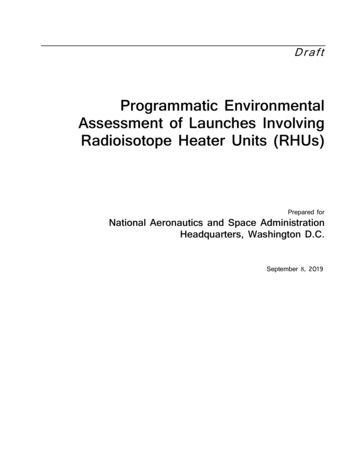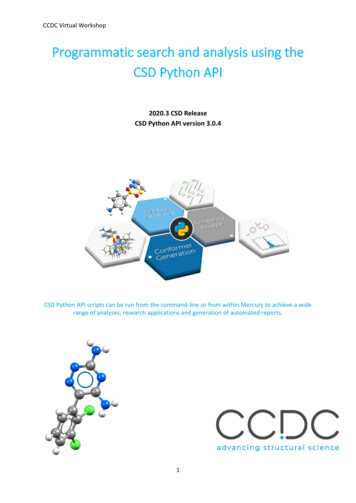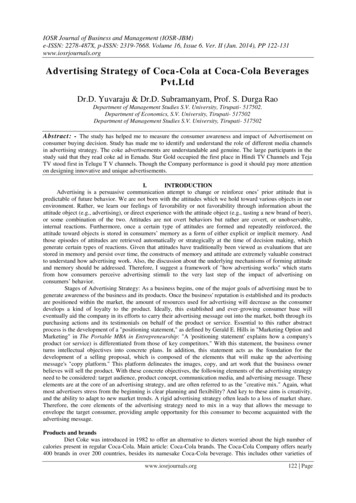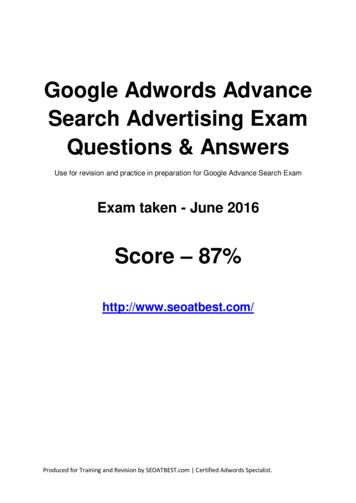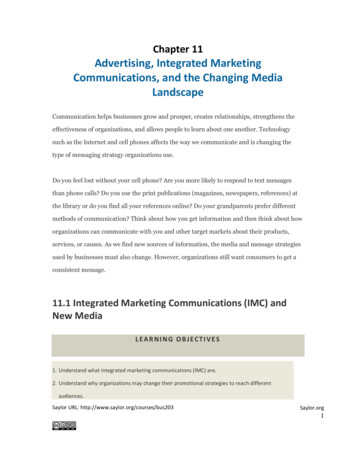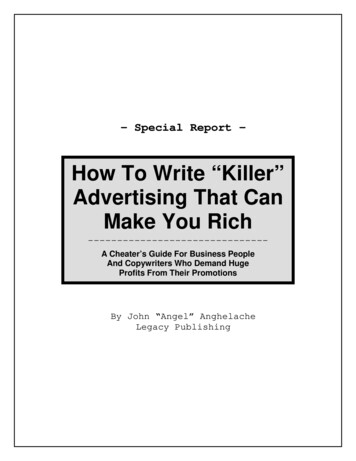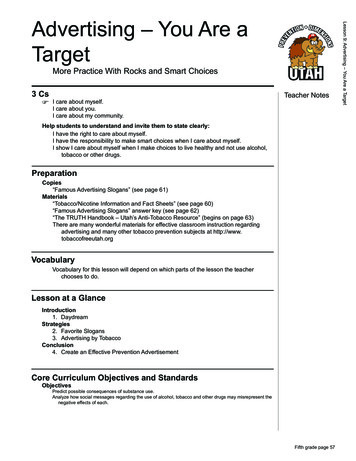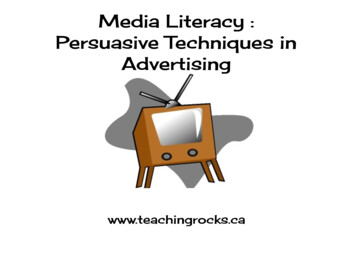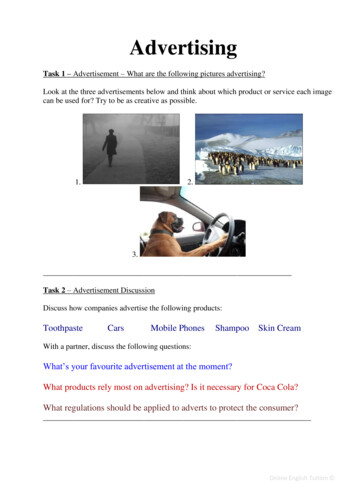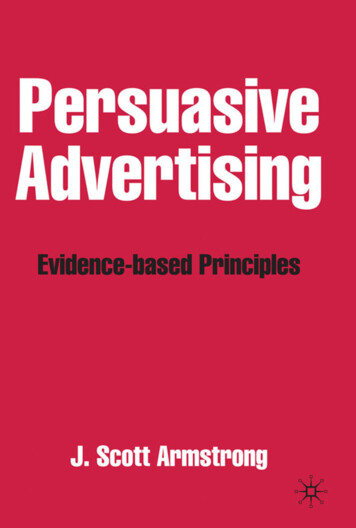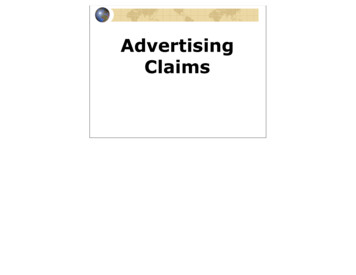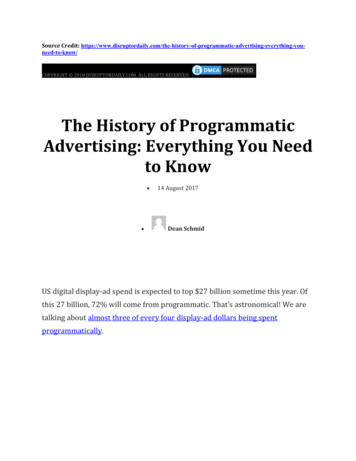
Transcription
Source Credit: PYRIGHT 2018 DISRUPTORDAILY.COM. ALL RIGHTS RESERVED.The History of ProgrammaticAdvertising: Everything You Needto Know 14 August 2017Dean SchmidUS digital display-ad spend is expected to top 27 billion sometime this year. Ofthis 27 billion, 72% will come from programmatic. That’s astronomical! We aretalking about almost three of every four display-ad dollars being spentprogrammatically.
And considering the relatively short time frame programmatic has had to workwith it is even more impressive. Unlike other marketing forms that just adaptedto the internet, programmatic was created online. But how and when didprogrammatic begin?The History of Programmatic Advertising:Everything You Need to KnowThe precursor to programmatic advertising was the banner ad. There wasnothing programmatic about this banner ad but the trusty 468 60 banner gaveus a template that advertisers would build on for decades.
This was the world’s first banner advertisement. We have Hotwired.com to thankor hate for it. In 1994, they signed a deal with AT&T to display this ambiguousimage on their site for 3 months.Lots of people did click their mouse right there. It achieved click-through ratesbetween 40 – 50%, which is pretty extraordinary. I mean, just think about thatfor a second; half of all the people that saw that banner ad clicked on it.Today, banner ads average an engagement of around 0.06%.What happened?There are all kinds of elegant marketing theories, but the law of shitty click-throughs is a personal favorite. ‘All marketing strategies will eventually fail,’words you should live by. Substantiated by the entire history of marketing, notjust programmatic.
Anyway, time went on, websites were created, and morning shows told us theinternet was going to rot our children’s brains. In other words, it was slowlylegitimized and integrated with society. There was money to be made, andadvertisers were eager to buy up more online real-estate.
In 1996, the first ad servers were created to meet the insatiable desireadvertisers had to place banners online. DoubleClick was arguably the first adserver, and it continues to supply ads today.Google purchased the company in 2007 for 3.1 billion.Even these ad servers couldn’t quench the industry’s thirst for web ads and in1998 – 2000 we saw the very first ad networks beginning to take shape.
Brands could now advertise on multiple sites across entire platforms. A lot of adservers have been released since but, 24/7 Open AdStream, Advertising.com,Value Click, and Zedo, are just some of the noteworthy ad networks that cameout before 2000.Then in 2000 Google released their prodigal AdWords. Originally launched with350 advertisers, AdWords wasn’t the beginning of programmatic advertising,because it only allows campaigns to run within the Google network.AdWords brought clarity to online advertising. 2 years after AdWords released ithad CPC pricing, and the search engine had a tidying effect on the cluttered predotcom crash internet.
In 2013 Google released their display ad network called AdSense. Google’sDisplay Network (GDN) was available through AdWords and limited toGoogle/DoubleClick properties. Remember I said that Google bought DoubleClickin 2008?Targeting segments are defined by demographic data, search queries, and basicbehavioral targeting. When Google crawls sites, and at the impression, the GDNsoftware reads the text on the webpage. This is then compared to the segmentdata and relevant ads are served.I don’t want to give the impression that Google was the only company servingads in this almost programmatic way.
eZula, Gator, IndustryBrains, About.com’s and Sprinks were all working onsimilar ad networks, but Google definitely had a leg up because of the popularityof their search engine, and their acquisition of a company called AppliedSemantics and DoubleClick.AdSense, and the self-serve advertising it offered gave publishers a legitimatechannel to monetize their sites, but it also funded an era of trashy spam content.
Made for AdSense became synonymous with spam sites, content farms, anddoorway sites that attracted an audience for the clicks.The Panda Update, in 2011, was Google’s way of fighting back.
Marketers need to know about this kind of stuff because it can affect how oursites rank on search engine.Real-Time Bidding and What You and I ConsiderProgrammatic AdvertisingUp until now the history of programmatic has been somewhat linear. That nicechronological series of events where one innovation leads to another is a bit of asimplification, but it’s one that I can get away with. It all falls in adiscombobulated heap when advertisers catch wind of programmatic and itexplodes.Between 2007 – 2010, ad exchanges like Yahoo’s Right Media, Google AdEX,Microsoft AdECN, AdMeld, PubMatic, The Rubicon Project, and Open X all started
build RTB software that worked as a DSP, an SSP, an ad exchange, or somecombination of the three.Yahoo’s Right Media was arguably thefirst RTB ad exchange. The exchange started in 2007 and enjoyed a brief momentof brilliance before frizzling out and eventually dying in 2014.RTB platforms were coming into their own. DSPs and SSPsworking together to provide access to vendor-neutral RTB ecosystems meantthat advertisers were spending money targeting their core markets directly,seeing better engagement metrics, and at the end of the day making more money.
So far, I have only spoken about desktop programmatic, but since 2014 mobileprogrammatic has been growing faster than its desktop counterpart, and it hasbeen worth more since 2015.We use our phones to access the internet more than any other device. Part ofprogrammatic’s appeal is that creatives are served across devices with minimaleffort.
In spite of mobile programmatic’s popularity, it hasn’t been smooth sailing. Toimplement programmatic the ad platform needs to segment the user. This wasdifficult to do on a mobile device because phones don’t have cookies.
90% of the time on a phone is time spent in an application. Therein lies thesolution. By tracking users with SDKs and APIs built into mobile applications,programmatic found its way onto mobile devices.Header Bidding the Recent History ofProgrammatic AdvertisingPeople started talking about header bidding in 2014 and using it in 2015.Before header bidding, the programmatic auction was decided with somethingcalled the waterfall, and one is very difficult to understand without a firm graspof the other.Boromir is right; it is very difficult to say anything meaningful about headerbidding without discussing the waterfall that preceded it. Waterfall bidding, alsocalled the daisy chain, showed impressions to DSPs in order of the perceivedvalue of each channel.
It used historical data to show DSPs impressions, and you got to see it first if youhave bid more in the past.It didn’t matter is the third or fourth DSP was willing to bid higher for thatimpression. With waterfall bidding, you only got to bid after the pass back. Thepublisher was missing out on potential revenue, advertisers were wasting theirbudgets and not reaching their core marketers, and the audience wasn’t being
shown the most relevant advertisement.The Future of Programmatic AdvertisingLooking at the past of programmatic marketing we can see a technology that haschanged to simplify the relationship between advertiser and publisher and showads to segmented audiences.The programmatic trend is all about automation, and the reason we automate isto free up people power to focus on the tasks that matter. To this extent I think
programmatic will continue to automate and bravely seek out new platforms.It won’t be long before marketers are looking for realistic ways to getimpressions on VR, IOTs devices, and HUDS.
Programmatic is focusing more and more on behavioral targeting and betterqualifying leads. I think that alongside the rise of AI, big data, and accurateaudience segmentation, we will see an explosion in the data a DSP has to bid forimpressions, and the ad experience will be almost personal.About Dean Schmid
Brands could now advertise on multiple sites across entire platforms. A lot of ad servers have been released since but, 24/7 Open AdStream, Advertising.com, Value Click, and Zedo, ar e just some of the noteworthy ad networks that came out before 2000. Then in 2000 Google
